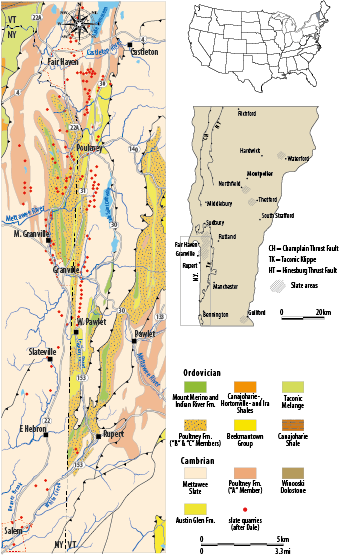|
Slate deposits of Vermont & New York
According to Dale (1914), four distinct slate regions exist in Vermont:
-
The western slate belt, which runs from Castleton, Fair Haven, Poultney, Wells and Pawlet (Rutland County) in Vermont to Salem in State New York. Here are the economically most important slate deposits with the quarries at West Castleton, Hydeville, Scotch Hill and Fair Haven. The Cambrian and Ordovician slates comprise the famous green and purple slates.
-
The black slates of Rutland County close to Benson and the Lake Champlain.
-
The central slate deposits of Northfield and Montpelier in Windsor County and Washington County.
-
This Silurian and Devonian slates are at the eastern flank of the Green Mountains. The dark-grey slates show a shiny surface and despite the speckled pyrite the slate does not show any brownish colouring. The slates show a classical fanning fracture cleavage.
The eastern slate belt begins in the south-east at Guilford (Windham County) and runs from North via Thetford (Orange County) to Waterford (Caledonia County). The slates show a dark-greyish to black colour and are of Silurian-Devonian age.
The western Slate Belt
Because the economically important slates lie within this belt the author focuses only on this area. This slate belt belongs to the northern Appalachians and lie within the western flank of the Green Mountains, within the 1,312-1,640 ft. high Taconic Range. The Green Mountains consist of Precambrian gneiss and mica slates (not equal to roofing slate!) which are easterly and westerly flanked by Paleozoic sediments (Balk, 1953).
On the map of Walcott (1888), the slates lie like a cord about 6 mi. NNE of Fair Haven (VT) via Granville (NY) to Salem (NY).

Slate is mined in the Cambrian 'Mettawee Slate Formation' and the Lower Ordovician (?) 'Indian River Formation'. The 'Mettawee Slate Formation' has a thickness of about 49-312 ft. with a well developed fracture cleavage (Rowley & Kidd, 1979) and corresponds to the 'Cambrian roofing slate' of Dale (Zen, 1961). In this formation alternating purple and greenish-grey slates occur. The general thickness of the greenish-grey slates is about 98-197 ft. and of the purple slates about 39-49 ft. Dark red slates are sometimes embedded within the purple slates (Dale, 1914). Dale mentioned a different behaviour of the slates on the roof in respect to weathering and colouring. These properties does not change within one stratigraphic level but rather within one unit and thus lead to the name like 'unfading green' and 'sea green'.
The 'Indian River Formation' is about 82-180 ft. thick and shows a well developed fracture cleavage. The colour varies between red, green to blue-green (Rowley & Kidd, 1979).
The Cambrian and Ordovician rocks comprise muddy deep sea deposits and less common sandy and carbonatic units which were deposited within the passive continental margin or slope, respectively. Two orogenic phases are important for the origin of this slates: The Taconic Phase as a continent-island-arc-collision 440 mill. years ago, followed by the Acadian phase as a continent-continent collision during the Devonian (350 mill. years). As for the slates, the Taconic Phase is the most important one and led to the name Taconic Range or 'Taconic Allochthon', respectively. The Acadian phase modified only existing structures.
At least two phases of deformation within the low-grade metamorphism can be figured out in the Taconic units (Zen, 1961). Within the 'Taconic Allochthon' the Taconic mountain building led to great north-east striking structures in form of large recumbent and overturned folds which are partly sheared and thus gave rise to thrust from East to West. It hereby overlays and is embraced by autochthonic and para-autochthonic shallow-marine rock units of the same age (Rowley & Kidd, 1979). Together with this folding a fracture cleavage developed mostly as a fanning fracture cleavage (Balk, 1953). The following second deformation phase modified existing structures and led to a crenulation foliation with different intensity. The area shows numerous wedges and thrust sheets which differ in stratigraphy and structure (Rowley & Kidd, 1979).
In Vermont and New York the history of slate mining began about 1839 when Welsh families immigrated. It were the Welsh people who founded with the 'Penrhyn Slate Company' the first slate company in Granville (NY) in 1852 (van Diver, 2001).
There were about 100 slate quarries in the area of Fair Haven, Castleton, Poultney and Pawlet, although most of them are abandoned. Fair Haven is the center of Vermont's slate industry and is the only slate district which comprises all slates in respect to colour.
Nowadays, about 10 slate quarries are in operation and slate is mainly used for roofing.
Pictures
Please move over thumbs to see larger photographs.
|

